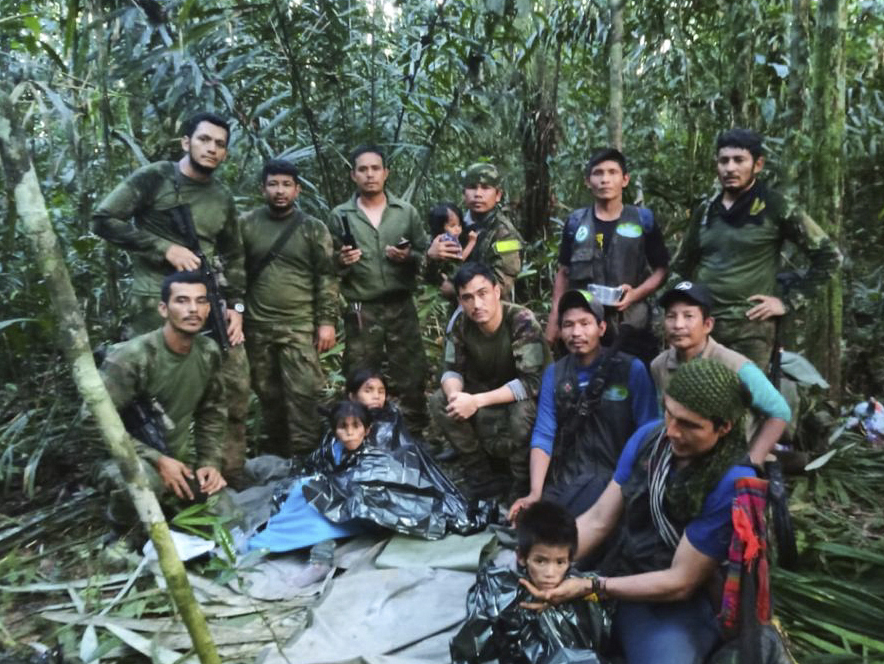 |
In this photo released by Colombia's Armed Forces Press Office, soldiers and Indigenous men pose for a photo with the four Indigenous children who were missing after a deadly plane crash, in the Solano jungle, Caqueta state, Colombia, Friday. (AP-Yonhap) |
BOGOTA, Colombia -- Four Indigenous children survived an Amazon plane crash that killed three adults and then braved the jungle for 40 days before being found alive by Colombian soldiers, bringing a happy ending to a search-and-rescue saga that captivated a nation but also prompted questions about their extraordinary survival.
Officials in the South American country announced their rescue Friday, following days of highs and lows as searchers frantically combed through the rainforest hunting for the youngsters, members of the Huitoto people and aged 13, 9 and 4 years and 11 months.
As the children received treatment Saturday at a hospital in the capital, Bogota, authorities were yet to explain how the siblings endured their time alone in the remote area. Earlier, officials had said the oldest children had some knowledge of how to survive in the rainforest.
President Gustavo Petro celebrated the news upon returning from Cuba, where he signed a cease-fire with representatives of the National Liberation Army rebel group. He visited the children Saturday.
Petro called them an "example of survival" and predicted their saga "will remain in history."
Damaris Mucutuy, an aunt of the children, told a radio station that "the children are fine" despite being dehydrated and with insect bites. Mucutuy, who arrived at the hospital at dawn with other family members, said the children had been offered mental health services.
Defense Minister Iván Velásquez told reporters Saturday the children were being rehydrated and cannot eat food yet. "But in general, the condition of the children is acceptable," he said.
An air force video showed a helicopter using lines to pull the youngsters up because it couldn’t land in the dense rainforest where they were found. The military on Friday tweeted pictures showing a group of soldiers and volunteers posing with the children, who were wrapped in thermal blankets. One of the soldiers held a bottle to the smallest child’s lips.
Gen. Pedro Sanchez, who was in charge of the rescue efforts, said that the children were found 5 kilometers (3 miles) away from the crash site in a small forest clearing. He said rescue teams had passed within 20 to 50 meters (66 to 164 feet) of where the children were found on a couple of occasions but had missed them.
"The minors were already very weak," Sanchez said. "And surely their strength was only enough to breathe or reach a small fruit to feed themselves or drink a drop of water in the jungle."
Fidencio Valencia, an uncle of the children, told reporters outside the hospital that the survivors were happy to see family members, who are taking a "day-by-day" approach to the situation.
"When the plane crashed, they took out (of the wreckage) a fariña, and with that, they survived," Valencia said, referring to a cassava flour that people eat in the Amazon region. "After the fariña ran out, they began to eat seeds."
The crash happened in the early hours of May 1, when the Cessna single-engine propeller plane with six passengers and a pilot declared an emergency due to an engine failure. Snakes, mosquitoes and other animals abound in the area.
The small aircraft fell off radar a short time later and a frantic search for survivors began. Two weeks after the crash, on May 16, a search team found the plane in a thick patch of the rainforest and recovered the bodies of the three adults on board, but the small children were nowhere to be found.
Sensing that they could be alive, Colombia’s army stepped up the hunt and flew 150 soldiers with dogs into the area. Dozens of volunteers from Indigenous tribes also helped search.
During the search, in an area where visibility is greatly limited by mist and thick foliage, soldiers on helicopters dropped boxes of food into the jungle, hoping that it would help sustain the children. Planes flying over the jungle fired flares to help search crews on the ground at night, and rescuers used speakers that blasted a message recorded by the siblings’ grandmother, telling them to stay in one place.
Rumors also emerged about the children's whereabouts and on May 18 the president tweeted that the children had been found. He then deleted the message, claiming he had been misinformed by a government agency.
The group of four children were travelling with their mother from the Amazonian village of Araracuara to San Jose del Guaviare when the plane crashed.
Petro on Friday said the children were first found by one of the rescue dogs that soldiers took into the jungle. He added that for a while he had believed the children were rescued by one of the nomadic tribes that still roam the remote swath of the jungle where the plane fell and have little contact with authorities.
As the search progressed, soldiers found small clues in the jungle that led them to believe the children were still alive, including a pair of footprints, a baby bottle, diapers and pieces of fruit that looked like they had been bitten by humans.
"The jungle saved them," Petro said. "They are children of the jungle, and now they are also children of Colombia." (AP)







